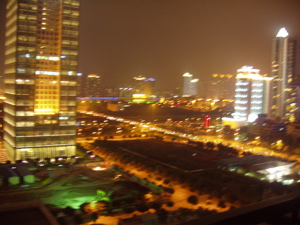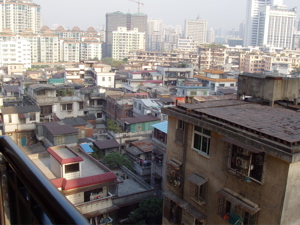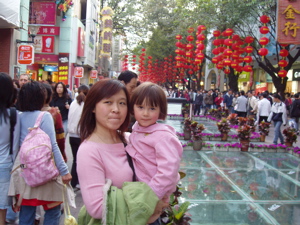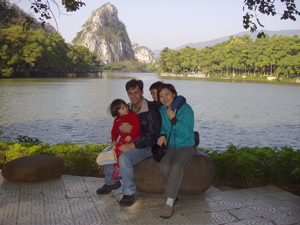

This time, I didn’t recognize Guangzhou.1 The construction site that I remember from previous visits has turned into a pretty, pleasant city. The air is better, and people seem happier and friendlier.
There’s still plenty of construction, but it’s now thriving-city construction, instead of rebuilding-from-scratch construction. Construction cranes appear every few blocks, instead of on every other block. Some relatively new buildings are getting face lifts, but buildings in the 15- to 25-year age range appear to be settled in for the long haul.
 |  |
In contrast, Beijing’s current re-construction — a crane on every other block — resembles Guangzhou from five years ago. It’s not that Beijing started later, I think, but that it’s being re-built even more aggressively. Buildings in the 10- to 15-year range (the age of the white-tile facade) are being replaced by 30-story highrises in Beijing. Guangzhou still has a lot of old, twisty neighborhoods, which are the sort being flattened in Beijing to make way for other highrises.
At the same time, Guangzhou seems to have be suffering from Beijing-like sprawl. The city is now even larger geographically than I remember. Wen’s father lives in a area full of highrises that was a relatively sparse suburb ten years ago. (The new opera house is going up a block away.) With 10 million people and counting, probably there’s no alternative to sprawl. Traffic is not as bad as Beijing, but getting from place to place by car takes a long time. The half-finished subway systems in both cities should eventually help a lot.
For now, a stay in Guangzhou is a nice break from Beijing’s rumbling growth. It was also a great place to spend December: even after most construction is over in Beijing, its residents won’t enjoy the great sub-tropical weather of Guangzhou.
 |
Besides less construction, the only other change I noticed is that spoken Mandarin seems to be replacing Cantonese. This may be my imagination, since I now understand more Mandarin, but I don’t think so. Many people have moved into the city from other parts of China, swelling the ranks of Mandarin speakers. In a store or restaurant, Wen’s parents generally start a conversation using Mandarin instead of Cantonese, because service workers are often from elsewhere; they pay is too low for the local, Cantonese-speaking population.
During mid-December, we visited Zhaoqing, which is in Guangdong province about two hours by car from Guangzhou. It’s on the west fork of the Pearl river, surrounded by mountains. It also has a few of the kind of mountains you see in traditional Chinese paintings: impossibly steep and just wide enough that you don’t expect them to fall over. We visited Zhaoqing University, where Wen performed a concert with Hsiao-Mei and Benjamin Ward. Besides Zhaoqing’s renowned scenery, there’s a famous monastery, a giant metal cauldron,2 and tasty freshwater shrimp.
 |
For scenery, Zhaoqing was a warm-up for Guilin, which we visited just after Christmas. Guilin is one of China’s major tourist attractions, and a picture of its Li river flowing through carst formations is on the back of the Chinese 20-yuan bill. We toured the city, went into the famous cave, took a boat down the Li river, saw the old banyan tree, and hit pretty much all of the famous sites. Guilin is set up for big crowds, but it was quiet in December.
 |  |
 | |
We toured Guilin in a group with 12 people, including Hsiao-Mei, her daughter Amy who lives in Beijing, friends Jim and Rebbecca from Bangkok/Malaysia, Wen’s youngest uncle and Aunt Xuanji, and Xuanji’s friends from Hong Kong. Xuanji found us a tour package with remarkably good food. Oliver and Sophie travelled extremely well, and they were the stars of the trip, offering nightly performances of Chinese songs that Wen taught them.
 |  |
Our tour included a couple of stops of the sort that I’ve only seen on Chinese tours,3 which an the outlet store for some silk, jade, handicraft, or jewelry company. The stop always starts with an educational overview (such as how to distinguish a real pearl from plastic) and ends with the opportunity to buy stuff. The tour guide presumably gets a commission. It’s similar to having a tour guide take you through a particular shop as part of his routine, but this kind of stop is much more direct and organized. The outlets are equipped to handle large groups, and they are apparently government-regulated to ensure that the goods are authentic. That’s how we ended up with a silk comforter.
After flying back Guilin, we took a brief trip to Xinhui, which is a pretty little town of 800,000 people near the coast outside of Guangzhou. In Wen’s family, Xinhui is mostly famous as the place where youngest uncle spent eight years on a farm during the Cultural Revolution. We stopped by the village where he lived, and where farmers still live in small brick shacks (a step up from the small wooden shacks of thirty years ago).
 |
After Xinhui, we returned to Beijing. As the plane landed, we could see a little snow and ice on the ground — which was expected, but it still made an impression on us after a month of palm trees. I’m ready for spring.
| 1 | Unlike last time. |
| 2 | I don’t really get the cauldron, but it is impressively large. Visitors throw red flags into it for good luck. |
| 3 | We visited the Great Wall near Beijing as part of a tour. |
| Prev: Learning the Language | Contents: A Year in China: 2006-2007 | Next: Winter and New Year |